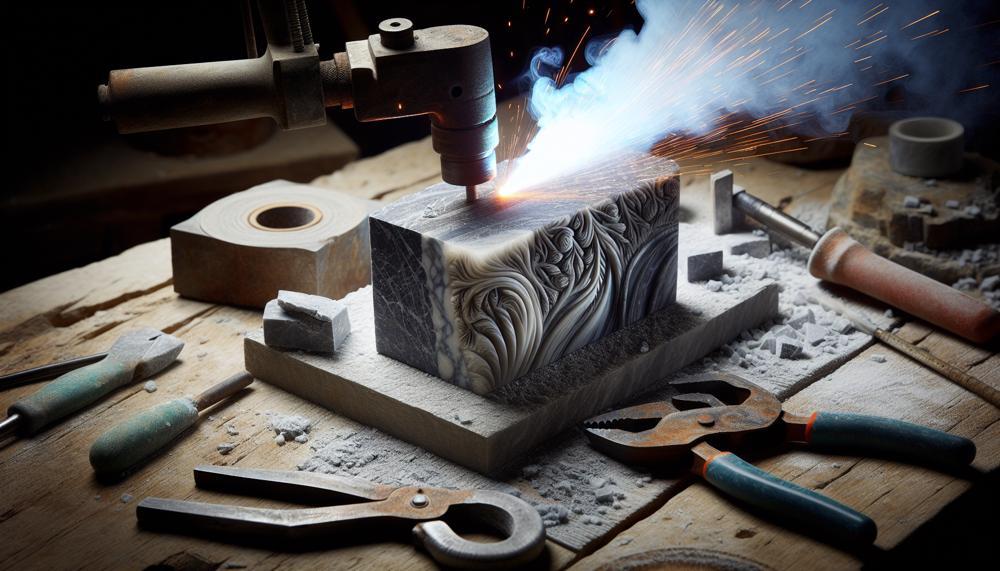In the world of welding, where precision and durability are paramount, one might be surprised to learn about the role of a seemingly unremarkable material: soapstone. This natural mineral, known for its resistance to heat and its ability to be carved into almost any shape, plays an indispensable role in the welding process.
In this blog post, we’re diving deep into the world of soapstone and its applications in welding.
So, what is soapstone used for in welding?
While working, welders use soapstone as a marker to make temporary white lines on metal. Soapstone can handle heat and stays clear when heated, which makes it perfect for putting metals together in ways other than welding. Also, soapstone marks are easy to get rid of and won’t mess up welds.
Soapstone is a rock that has changed over time and is very heat-proof. People frequently cast metals into it, such as lead, pewter, and silver. For a long time, people have also used soapstone to make food pots, pizza stones, fires, wood-burning stoves, and even tobacco pipes.
Plus, seamstresses, builders, and other artists use soapstone as a way to make marks.
Whether you’re a seasoned welder or new to the trade, understanding the role of soapstone can elevate your welding projects to the next level. Let’s explore how this natural material makes a big impact in the precise world of welding.
Contents
- 1 How is Soapstone Formed?
- 2 What is a Soapstone Marker?
- 3 What Is Soapstone Used for in Welding
- 4 What are the Different Uses of Soapstone?
- 5 Are Soapstone Marks Easy to Erase?
- 6 What is Welders’ Soapstone Made of?
- 7 How Does Welders’ Soapstone Differ from other Types of Markers?
- 8 Advantages of Using Soapstone in Welding
- 9 Disadvantages of Using Soapstone in Welding
- 10 Conclusion
How is Soapstone Formed?
Soapstone’s journey from the depths of the earth to a welder’s toolkit is a tale of transformation through heat, pressure, and chemical alteration. Here’s how it unfolds and influences its role in welding:
How is Soapstone Formed?
| Origin | Process | Composition |
| Metamorphic Rock | Regional metamorphism and metasomatism at convergent plate boundaries. | Mainly talc, with amphiboles, chlorite, and minor iron-chromium oxides. |
| Parent Rocks | Transformation from dunites, peridotites, serpentines, and siliceous dolostones. | Varying talc content affecting physical properties. |
Soapstone is born out of intense conditions beneath the earth’s surface, where parent rocks undergo a transformation. Heat and pressure, coupled with the infusion of chemically active fluids, lead to regional metamorphism and metasomatism. These processes alter the original rock’s composition, texture, and mineral structure, giving rise to soapstone’s characteristic soft, dense, and non-porous nature.
Implications for Welding
- Heat Resistance: Its formation under high heat renders it remarkably resistant to temperature, making it ideal for withstanding the extreme conditions of welding.
- Non-Porous Nature: This characteristic, a direct result of its metamorphic origins, means soapstone doesn’t absorb liquids or gases, ensuring clean, uncontaminated marks on welding projects.
- Soft and Easily Carvable: The high talc content, a result of its unique geological formation, allows soapstone to be easily shaped into markers for precise application in welding.
These geological processes and properties not only narrate the story of soapstone’s creation but also highlight its indispensable role in welding.
What is a Soapstone Marker?
A soapstone marker, crafted from talc or magnesium silicate, stands as a vital tool in the welding trade. Known for its exceptional heat resistance and non-porous nature, this marker offers the ability to make precise, temporary marks on metal surfaces, crucial for guiding welds, marking cuts, or plotting layouts.
Usage in Welding:
- Marking weld locations: Ensures accurate alignment before welding begins.
- Identifying materials: Helps keep track of different metals and their intended use.
- Creating patterns: Assists in laying out cutting lines or decorative designs on metal surfaces.
Advantages:
- Heat and corrosion-resistant: Ideal for the high temperatures and harsh conditions of welding.
- Versatility: Can be shaped into various sizes for different marking needs.
- Smooth finish aid: Contributes to a cleaner weld by marking where to join metals.
- Easy removal: Marks can be wiped away with a damp cloth, keeping the metal surface clean.

Table of Unique Properties and Uses:
| Property | Benefit in Welding | Practical Application |
| Heat Resistance | Withstands high temperatures without burning away. | Marking weld paths on metal surfaces. |
| Non-porous Nature | Does not absorb materials or deteriorate. | Creating durable and visible marks. |
| Easy to Shape | Customizable for specific marking needs. | Designing patterns and identifying materials. |
What Is Soapstone Used for in Welding
Soapstone, with its unassuming nature, emerges as a cornerstone in the welding world, bridging ancient artistry with modern metalwork.
This humble metamorphic rock, primarily composed of talc, is both soft and dense, making it an unsung hero in the welding arena.
Main Functions of Soapstone in Welding
- Marking Guidelines: Soapstone’s primary role in welding is for marking. Its softness allows it to glide over metal surfaces, leaving clear, visible lines without damaging the material. These marks serve as guides for welders, ensuring precision in their work.
- Heat Resistance: Thanks to its remarkable resistance to heat, soapstone plays a critical role in welding. It withstands the high temperatures generated during welding, ensuring that the marks remain visible throughout the process.
- Chemical Resistance: Soapstone’s non-reactive nature makes it an ideal choice for environments where chemical reactions are a concern. It does not react with the metals or the welding materials, maintaining its integrity and the accuracy of the markings.
- Versatility: Available in various colors and capable of changing hue when exposed to heat, soapstone allows for differentiation between different phases of the welding process or marking specific types of metals.
Practical Applications
- Temporary Marking: For identifying materials, indicating welding directions, and outlining patterns or cuts before the actual welding takes place.
- Gap Filling: Its ease of manipulation and shaping allows soapstone to be used for filling gaps between metal pieces, aiding in a stronger bond and a smoother finish.
- Heat and Corrosion Management: It helps in reducing heat generation during welding to prevent warping of the metal and resists corrosion in harsh environments.
Handling and Usage
| Property | Advantage | Consideration |
| Low Melting Point | Easy to shape and manipulate | Marks may not be permanent |
| High-Temperature Resistance | Maintains integrity under heat | May require ventilation due to chemical content |
| Non-Reactive | No interference with welding process | Visibility issues on shiny surfaces |
Considerations
While soapstone is invaluable in welding for its myriad of benefits, it’s not without its drawbacks. Marks can smudge or fade, requiring frequent reapplication, and it may be challenging to spot on glossy surfaces.
Moreover, despite its heat resistance, the permanence of soapstone markings under intense welding conditions can vary, necessitating careful planning and application.
What are the Different Uses of Soapstone?
Soapstone, with its talc-rich composition, emerges as an indispensable ally in the welding realm, celebrated for its resilience to heat and chemical wear. Its utility spans across marking metals, heat management, and serving as a flux in soldering or brazing. The unique properties and diverse applications of soapstone make it a cornerstone in welding projects, ensuring precision and durability.
Utility in Welding:
- Marking Precision: Soapstone markers are essential for scribing clear, visible lines on metal surfaces. These markings guide welders with precision during the welding process.
- Heat Resilience: Its remarkable resistance to high temperatures allows soapstone to remain intact, without melting or distorting under the intense heat of welding.
- Fluxing Agent: In soldering or brazing, soapstone acts as a flux, facilitating a cleaner, stronger bond between metal pieces while minimizing heat-induced damage.
Benefits:
- Versatility: Easily shaped into various sizes and forms, soapstone markers cater to a wide range of welding tasks.
- Safety: Its non-reactive nature ensures soapstone is safe to use in corrosive settings, posing no risk of unwanted chemical reactions.
- Eco-friendliness: Unlike some chemical markers, soapstone is natural and less hazardous, although proper ventilation is advised during use due to potential chemical components.
Limitations:
While soapstone’s benefits are manifold, it’s crucial to note that its markings, though highly visible, are not permanent and may smudge on glossy surfaces.
Additionally, the potential presence of hazardous chemicals necessitates adequate ventilation during use.
| Property | Application in Welding | Benefit |
| Heat Resistance | Withstands intense welding temperatures | Prevents alteration under heat |
| Chemical Resistance | Safe in corrosive environments | Ensures durability and safety |
| Marking Capability | Accurate scribing on metals | Guides welders with precision |
In the crucible of welding, soapstone’s attributes—heat resistance, chemical inertness, and marking proficiency—make it an irreplaceable tool.
Its ability to endure the rigours of welding while offering clear guidance and ensuring safety underscores its vital role.
Are Soapstone Marks Easy to Erase?
In the realm of welding, the question of whether soapstone marks are easy to scrub away garners keen interest. Let’s delve straight into the heart of the matter, drawing from hands-on experience and a bit of grit.
Ease of Erasing Soapstone Marks in Welding
Soapstone, with its talc composition, serves as a steadfast companion to welders. Its resilience against heat and chemicals, coupled with its marking prowess, makes it indispensable.
Yet, its real charm lies in the ease with which one can erase its marks.
| Characteristic | Detail | Impact on Erasability |
| Composition | Primarily talc | Marks are soft and non-permanent |
| Color Changes | May alter under high heat | Visibility can decrease, but erasure remains straightforward |
| Application Surface | Varied (metal, shiny, rough) | Easier on rough surfaces; may require effort on shiny ones |
| Hazardous Chemicals | Generally absent | Safe for regular handling and erasure |
| Visibility | Can be challenging on shiny surfaces | Refreshing marks is simple, aiding in their eventual removal |
Soapstone’s marks are renowned for their simplicity in removal. A standard rag or steel wool, without the need for solvents, typically does the job.
This attribute not only underscores soapstone’s role in welding for temporary guidelines but also its eco-friendly and user-safe profile. The marks, while durable enough to withstand the rigours of welding, do not outstay their welcome.
What is Welders’ Soapstone Made of?
Welders’ soapstone, an indispensable tool in the welding trade, is crafted from a harmonious blend of natural minerals. The primary component is talc, renowned for its softness, which accounts for the soapstone’s ability to make smooth, easily visible marks on metal.
Alongside talc, the composition is enriched with magnesium, lending the stone durability and resistance to heat. Calcium contributes to the structural integrity of the soapstone, while silicon enhances its resistance to wear and tear. Iron, though a minor component, imparts a subtle coloration to the soapstone, aiding in the visibility of marks.
This symphony of minerals is meticulously melted and ground into a fine powder, then compressed into sticks or formed into other shapes suitable for marking metal surfaces in welding operations. The blend of these minerals ensures the soapstone’s effectiveness in marking, durability under high temperatures, and ease of removal after welding tasks are completed.
| Mineral | Role in Soapstone | Benefits in Welding |
| Talc | Main component | Softness allows for smooth marks |
| Magnesium | Strengthens | Enhances durability and heat resistance |
| Calcium | Structural integrity | Improves soapstone’s structural strength |
| Silicon | Wear resistance | Boosts resistance to wear and tear |
| Iron | Coloration | Improves mark visibility on metal |
How Does Welders’ Soapstone Differ from other Types of Markers?
Welders’ soapstone stands out from other marking tools for its unique combination of properties, making it particularly suited for the challenging conditions of welding.
Its distinctiveness lies not only in its composition but also in its practical benefits for the welding process.
Unique Composition and Properties
| Property | Welders’ Soapstone | Other Markers |
| Main Composition | Talc/Magnesium Silicate | Varies (ink, paint, graphite) |
| Heat Resistance | Exceptional | Moderate to Low |
| Chemical Resistance | High | Varies |
| Melting Point | Low | Higher |
Practical Advantages in Welding
- Durability Under High Temperatures: Soapstone’s ability to withstand intense heat without melting or burning away is critical. It ensures the markings remain visible throughout the welding process, guiding welders accurately.
- Non-reactivity: Its chemical inertness means it doesn’t react adversely with the metals being welded or the gases produced during the process, ensuring the integrity of the weld.
- Versatility and Ease of Use: Soapstone can be easily shaped into markers of various sizes, making it adaptable for different tasks. Its softness allows for smooth, clear marks on metal surfaces, providing precise guidelines for welders.
- Affordability and Accessibility: Not only is soapstone more affordable than many other markers designed for high-temperature environments, but it is also widely available, making it a go-to choice for welders worldwide.
- Environmental and Health Safety: Being a natural, non-toxic material, soapstone is safer for welders to use regularly. It doesn’t emit harmful fumes or particles when exposed to high temperatures, unlike some chemical-based markers.
Why Preferred in Welding
Welders favor soapstone due to its perfect balance of practicality, safety, and cost-effectiveness. It delivers reliable performance in the demanding context of welding, where precision, durability, and safety are paramount.
Advantages of Using Soapstone in Welding
Soapstone, revered for its remarkable properties, stands as a linchpin in the realm of welding, bringing forth an array of advantages that significantly contribute to the welding process. Its ability to resist heat and chemicals, combined with its non-reactive nature, positions it as an indispensable tool for welders.
Here’s how soapstone marks its presence as a game-changer in welding projects:
| Heat Resistance | Soapstone’s resilience against high temperatures ensures it does not crack or become brittle under the welding torch’s intense heat. |
| Chemical Resistance | Its chemical inertness allows it to withstand corrosive environments, making it suitable for a variety of welding projects. |
| Versatility in Marking | Whether it’s outlining weld locations or guiding cuts, soapstone’s adaptability in marking metal surfaces is unmatched. |
| No Special Preparation | Ready to use without any prior treatment, soapstone is a cost-effective option for welders. |
| Reduces Heat Impact | By mitigating the heat generated during welding, it helps in reducing metal warping, ensuring stronger welds. |
The tenacity and beauty of soapstone have been celebrated through ages, finding its place in sculptures to countertops, and now, in the heart of welding workshops. Its simplicity in shaping allows for customisation to the task at hand, providing precise markings that are essential for accurate welds.
Moreover, its property as a flux agent when soldering or brazing amplifies its utility in welding processes, offering a smoother experience for welders.
Disadvantages of Using Soapstone in Welding
In the realm of welding, soapstone, despite its robustness and versatility, harbors certain limitations.
To address the question of its potential drawbacks in welding, let’s dissect these in detail.
Impermanence of Markings:
Soapstone’s chief disadvantage lies in the fleeting nature of its markings.
When precision is paramount, this can lead to frequent reapplications, disrupting workflow and efficiency.
Visibility Challenges on Certain Surfaces:
Another challenge emerges with its use on shiny metal surfaces where visibility is diminished.
This can hinder accuracy in critical welding operations.
Potential Health Concerns:
Though not widespread, the presence of certain chemicals in soapstone necessitates adequate ventilation to mitigate health risks, especially in confined spaces.
Time-Consumption in Refreshing Markings:
The need for regular refreshing of soapstone markings, while ensuring precision, can be a time-consuming aspect, impacting overall project timelines.
Here’s a tabulated view for a clearer understanding:
| Drawback | Impact on Welding Process | Consideration for Welders |
|---|---|---|
| Impermanence of Markings | Frequent reapplications needed | Ensuring accuracy despite erasability |
| Visibility on Shiny Surfaces | Reduced marking visibility on certain materials | Finding alternative marking methods |
| Health Concerns due to Chemicals | Need for proper ventilation | Safety measures in closed environments |
| Time-Consuming Refreshing of Marks | Adds to overall project duration | Efficient time management in projects |
While soapstone stands as a stalwart ally in the welder’s arsenal, these limitations remind us that even the most dependable of tools must be employed with an understanding of their inherent constraints.
Conclusion
Soapstone is a simple but important medium for welding. It combines the accuracy of old-fashioned workmanship with the speed of modern metalwork. This fascinating, changing work of art, mostly made of talic, shines as an essential tool for welders. From deep in the ground to a welder’s toolbox, soapstone has unique qualities that make it a valuable addition to welding shops all over the world.
Marking is its major use; it guides welders precisely and makes sure that their work is not only exact but also stays solid even under the harsh conditions of welding. Because soapstone is metamorphic, it is resistant to heat and chemicals.
This means that it doesn’t change during the welding process, so the marks stay accurate even in places with high temperatures and chemicals that break them down. It is also very flexible; it comes in many colors and can change colors when heated, which makes it easy to tell the difference between markings and greatly improves the speed of work processes.
Soapstone can be used for more than just writing; it can also be used to fill in gaps and control heat, which shows how useful it is for improving welding results in many ways.
Even though it has benefits, users have to work around its problems, like the fact that marks don’t last long and are harder to see on shiny surfaces, by applying it strategically and making small changes every so often.
Using soapstone for welding is like using a tool that was made from the toughness of the earth itself. It not only makes welding projects more precise and long-lasting, but it also brings out the mix of simplicity and complexity that makes welding a skill.





